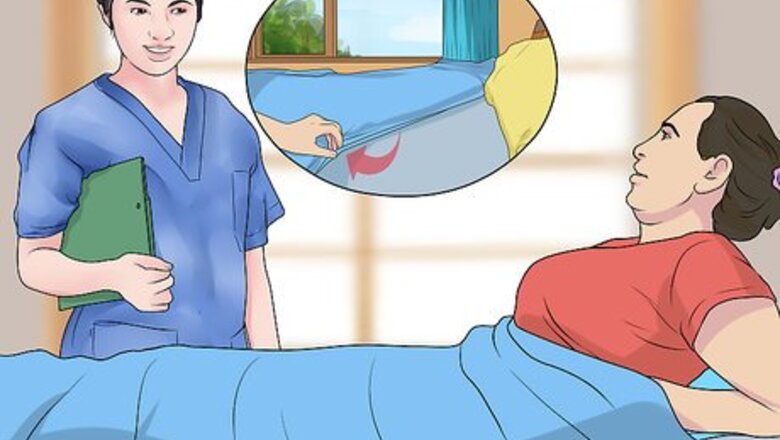
views
Setting up the Bedding
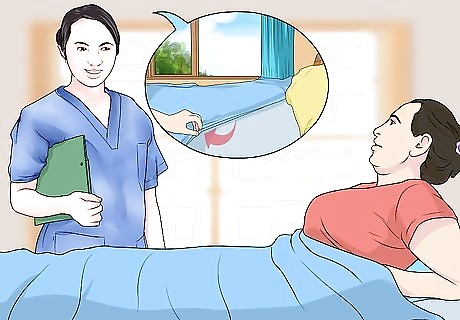
Tell the patient what you’re doing. Knock on the door before entering the room. Whether or not you think the patient can hear you, explain what you’re doing and make sure that you provide privacy for the patient. Close the blinds or curtains of any window as well as the patient’s privacy curtain. Introduce yourself and greet the patient using their name. Try saying, “Hello, [patient name]! My name is [your name] and I’m the CNA who will be changing your sheets today. First I’ll wash my hands, and prepare the supplies. I’ll be right back, okay?” If the patient is sitting upright, ask if it is alright that you lay them down flat.
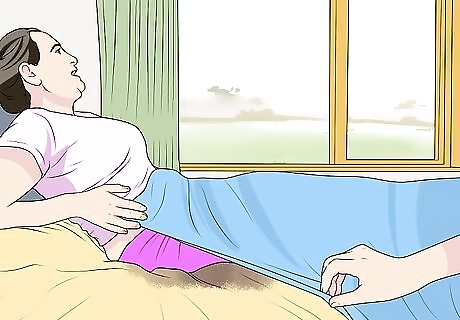
Check the state of the linens. You may not have to replace all the bedding every day. However, you may need to change the bottom and top sheets and the pillowcase regularly. The mattress pad, bedspread and blanket can remain if they are dry and unsoiled. Bedding that is at all dirty or wet from urine, stool, blood, emesis or perspiration should be changed.
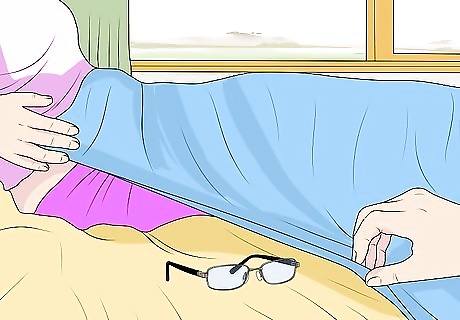
Check the bedding for items. Make sure there are no hearing aids, dentures, jewelry, glasses, tissues or other items in the bed before changing the linens. This way you will be able to remove soiled sheets without shaking them. Make sure no tubes are tangled in the bed sheets.
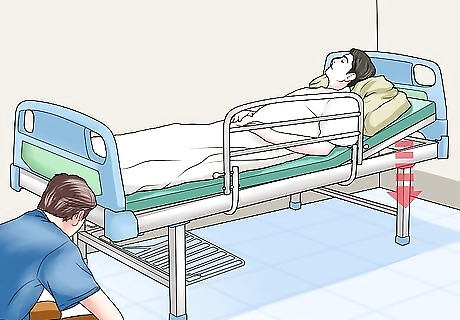
Adjust the bed. Put the bed at a comfortable height, and flat if possible. Ensure that you won’t have to stretch or bend over the bed in order to replace the bedding. Put the side rails up so the occupant won’t roll out and will have something to grasp onto. If the bed does not have side rails, you will need two people for this process: one for making the bed and the other for holding the patient securely on the bed. If there are wheels on the bed, make sure that they are locked.
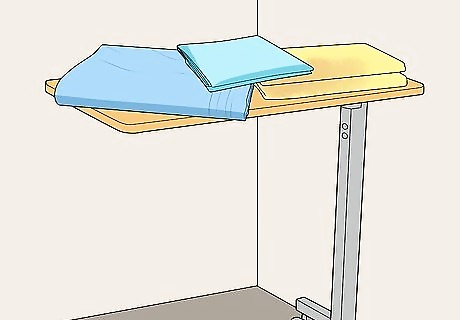
Create an area for clean supplies. Wash your hands and put on gloves. Have a clean surface such as a rolling table ready for holding the clean items. You can also use the overbed table as a work area. Only touch the supplies with clean hands. Put the clean items you need on the clean area. For example, a flat sheet, fitted sheet, and a pillow case. Also include a clean privacy blanket, and a draw sheet if desired.
Changing the Sheets
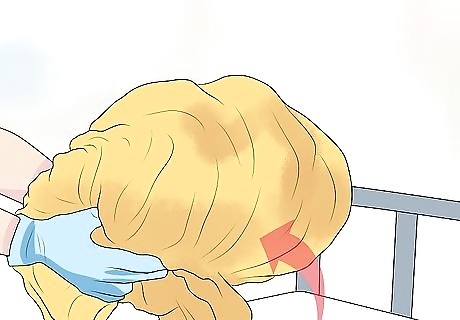
Remove soiled items. Hold soiled linens away from your clothing when transferring them to a hamper. Don’t shake the linens, as this can introduce micro-organisms into the air. If the clean linens accidentally touch the floor, put them in the dirty hamper and get new clean sheets. Don’t allow soiled linens to touch your face or uniform. If a hamper is not immediately available, place soiled sheets in a plastic bag or laundry basket. Never place them on the nightstand or floor, even temporarily.

Change the fitted sheet. Gently roll the patient onto their side. Remove the fitted sheet by rolling it towards the patient. Put a pad where the patient’s hips will lie. Then roll a clean linen towards you. Carefully roll the patient onto the clean linen. Tuck the corners and sides of the clean fitted sheet neatly under the mattress. Pull the clean linen tightly on the bed so that it’s wrinkle-free.
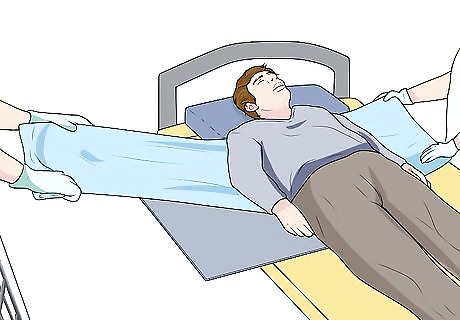
Use a draw sheet if you’re working with a partner. This will allow you to move the patient from side to side during the process. Fold a sheet in half and stretch it across the middle of the bed to use for this purpose. Place the draw sheet on top of the bottom sheet, from the patient’s shoulders to buttocks with at least six inches of sheet left on each side. Pulling the sheet on with a helper permits you to move even a large onto their side or higher up on the mattress. If you need a demonstration, ask an OT or PT.
Changing the Remaining Linens
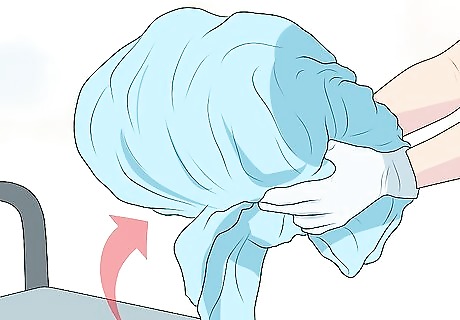
Remove the top bedding. Place a privacy blanket over the patient. Loosen the top bedding at the end of the bed. Fold the bedspread to the foot of the bed and take it away by holding it at the center. Repeat with the blanket. Only put the bedrail down on the side you’re working on. Never step away from the bed at all when the side rail is down. If the blanket and bedspread are dirty, replace them with clean ones. Otherwise place them over a chair while you change the sheets.

Remove the dirty pillowcase. Support the person’s head and neck as you remove the pillow. Gently rest the patient’s head back down on the bed. Remove the dirty pillowcase by unrolling it away from you. Put the pillowcase in the laundry hamper. Change your gloves to a clean pair. Try saying, “I’m going to use my hands to gently support your head and neck as I remove the pillow now, so that I can put on a fresh pillowcase for you.”
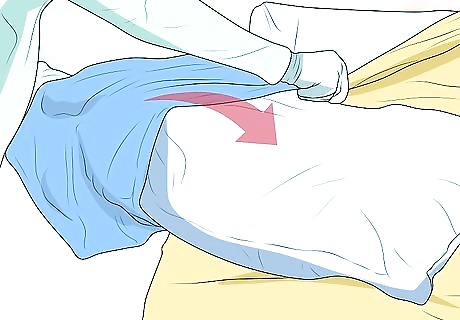
Put on a fresh pillowcase. Put the clean pillowcase over your hand and arm so that you can grasp the center of the pillow with your covered hand. Unroll the clean pillowcase onto the pillow. Carefully lift the patient’s head and neck and put the pillow with the clean pillowcase on it under their head.
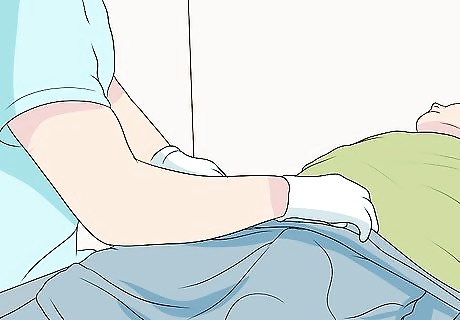
Cover the patient. Put a clean flat sheet and a blanket over the patient. Secure the lower corners of the sheet with mitered corners. Move the occupant into a comfortable resting position and adjust the bedding as needed.

Replace the top blankets and finish up. If the bedspread and blanket were soiled, replace them with new, clean ones. If not, you can put the original ones back on. Dispose of your gloves and wash your hands. Try telling the patient, “The bed is all clean and changed now. Thank you for your patience!” Remove the dirty items by taking them to a laundry area. Keep them in a plastic bag or laundry bag if they can’t be laundered immediately.















Comments
0 comment